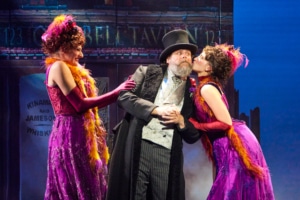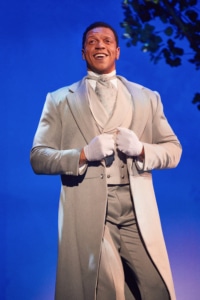DCPA NEWS CENTER
Enjoy the best stories and perspectives from the theatre world today.
Enjoy the best stories and perspectives from the theatre world today.
My Fair Lady, a famously sumptuous spectacle overflowing with a long list of favorite songs, has been called the perfect musical. The Alan Jay Lerner and Frederick Loewe original ran on Broadway starting in 1956, setting records for the longest Broadway run at the time.

Madeline Powell as Eliza Doolittle in The National Tour of MY FAIR LADY. Photo by Jeremy Daniel (4643).
The 1964 movie adaptation likewise became a classic, with Rex Harrison putting a defining stamp on the role of Henry Higgins, the stodgy professor who remakes a poor flower seller into a lady, on a dare, by cleaning her up and teaching her proper elocution.
He then more or less falls for her – or at least grows accustomed to her face. A slew of romantic comedies from Pretty Woman to Miss Congeniality have cashed in on this magic makeover formula ever since.
But this revival isn’t a nostalgic replay of a frothy film or theater piece. It represents an effort to make this lovely fantasy more relevant to modern sensibilities. The revival by director Bartlett Sher aims to fashion My Fair Lady as less rom-com, more social critique.
“It is helpful to look at the original source material,” Sher said in a telephone interview ahead of the Lincoln Center Theater production’s national tour arrival in Denver.
After all, he said, “Shaw was a radical socialist writer, very interested in the suffragette movement, hanging out with Sylvia Pankhurst and a part of the lot of new thinking about women in society.” The themes of the piece are class divisions and the constraints put on women.
With an outlook that can be considered quite progressive for his time, Shaw devised the plot of Pygmalion to test the idea of upward mobility in a culture defined by strict social class distinctions and misogyny.

Sami Murphy, Michael Hegarty as Alfred P. Doolittle and Ashley Agrusa in The National Tour of MY FAIR LADY. Photo by Jeremy Daniel (7275)
Spoiler alert: The ending has been altered to evoke Shaw’s clearly feminist, not so romantic intention.
To understand how he arrived at this new take, Sher said, you have to know the history. Of course My Fair Lady is based on George Bernard Shaw’s Pygmalion, written in 1911 with the suffragettes in mind.
“Shaw was quite a radical thinker, heavily influenced by Ibsen and A Doll’s House. He was dead set against the idea of a romantic comedy,” Sher said.
In 1938, a movie starring Leslie Howard was produced, written by Shaw from his Pygmalion. “But the studio was unhappy with the ending. They took the screenplay away from him and demanded a reshoot.” Cue the first steps toward a rom-com crowd pleaser.
Some 20 years later, the musical theater got the rights to the early movie and “kept the happy ending,” suggesting the pair get together in the end.

The Company of The National Tour of MY FAIR LADY. Photo by Jeremy Daniel (5117).
“By the time I got to it,” Sher said, “I reinstated a sense of the original ending.”
In this production, Henry Higgins does not sculpt Eliza Doolittle into his idea of a proper lady; rather, Eliza uses her bravery and pluck to imagine a better life for herself. At the close, this Eliza does not run to Higgins in a suggestion of happy-ever-after coupledom, but instead finds the strength to turn away and face her future, solo.
Sher sees the relationship between Eliza and Higgins as “profound and close, but not romantic.” Shaw’s intention, Sher said, was to write the opposite of a romantic comedy.
Younger, more open-minded theatregoers may cheer when Eliza stands up to the arrogant, narcissistic Prof. Higgins. Older, perhaps more nostalgic fans of the Julie Ansdrews and Audrey Hepburn versions may be stunned.

Cameron Loyal as Freddy Eynsford-Hill in The National Tour of MY FAIR LADY. Photo by Jeremy Daniel (6855).
But Sher is resolute. “The purpose of a revival is not to make people happy, but to provoke discussion.”
His work has been hailed a success to the tune of 10 Tony nominations.
The show’s musical numbers are here in all their glory – from “I Could Have Danced All Night: to “On the Street Where You Live” to “The Rain in Spain.” The glamour is intact. But the tale exits on a note that plays allegiance more to Shaw than to Lerner.
Classic works like My Fair Lady are “very much of their time and require investigation and rethinking.” Sher said, noting that Shaw also struggled with the ending in his day.
The idea, according to the director, is that “these are living texts.”
Sher is known for successfully reinterpreting and reworking such classics as South Pacific and The King and I, both of which contain troubling and outdated racial elements. With My Fair Lady, he’s made a classic from a classic for our more egalitarian era but, he asks, “Who knows, 20 years from now…?”
Lerner picks up from Shaw, Sher picks up from Lerner, but who picks up from Sher?
